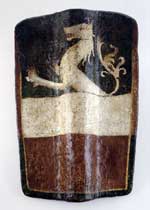From the collection of:
Frazier Historical Arms Museum || VAM Home
PAVISE, AUSTRIAN, late 15th century
V.14
Purchased from the Bernal collection, 1855
© The Board of Trustees of the Armouries
Courtesy of the Trustees of the Royal Armouries
Shields, used as portable defenses, evolved into many forms for different purposes. A pavise, like this one, was a large oblong or rectangular shield carried by an infantryman, particularly a spearman or crossbowman. While some pavises were carried, the larger ones were erected in free-standing positions. The central groove on this pavise indicates the location where a stake would be inserted to prop up the shield. The pavise originated in the northern Italian town of Pavia and eventually spread throughout most of Europe. This particular shield is decorated with the town arms of Enns, Austria.
A knight’s coat of arms was used to help identify him in battle. The colors and symbols used on the coat of arms were symbolic and highly specific to each family.
Classroom Ideas
Discussion: Why might knights have painted their shields? Why would it be important for them to have their coat of arms on their shields?
Activity: Using the coat of arms link below and other resources, create your own coat of arms.
Links
See more images of historic arms at the Frazier web site.
[www.frazierarmsmuseum.org/media/royal/royal.php]
Find out more about shields at the Shields and Objects web site created by the Pitt Rivers Museum, University of Oxford, in conjunction with the University of Kent.
[pittweb.prm.ox.ac.uk/Kent/]
Learn How To Make an Authentic Coat of Arms from Owl and Mouse Educational Software.
[www.yourchildlearns.com/her_act.htm]
The online manual Heraldry and Self-Representation in the Middle Ages, created by the Department of Medieval Studies at Central European University in Budapest, explains the history and types of shields.
[www.ceu.hu/medstud/manual/SRM/shield.htm]
Find out more about Britain’s Royal Armouries and artifact preservation at the armouries web site.
[www.armouries.org.uk]

